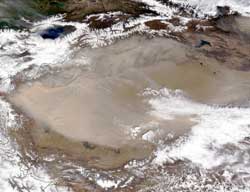Earth Sciences
Earth Sciences (also referred to as Geosciences), which deals with basic issues surrounding our planet, plays a vital role in the area of energy and raw materials supply.
Earth Sciences comprises subjects such as geology, geography, geological informatics, paleontology, mineralogy, petrography, crystallography, geophysics, geodesy, glaciology, cartography, photogrammetry, meteorology and seismology, early-warning systems, earthquake research and polar research.

Massive tsunami sweeps Atlantic Coast in asteroid impact scenario for March 16, 2880
If an asteroid crashes into the Earth, it is likely to splash down somewhere in the oceans that cover 70 percent of the planet’s surface. Huge tsunami waves, spreading out from the impact site like the ripples from a rock tossed into a pond, would inundate heavily populated coastal areas. A computer simulation of an asteroid impact tsunami developed by scientists at the University of California, Santa Cruz, shows waves as high as 400 feet sweeping onto the Atlantic Coast of the United States.

Model Helps Scientists Home In On Tropical Climate Controls
It has long been known that tropical climate – by redistributing vast amounts of solar energy through welling hot air and the formation of towering cumulous clouds – influences weather in other parts of the world.
It remains unclear, however, how much the tropics can be affected by higher latitudes.
Now, with the help of a sophisticated computer model, scientists at the University of Wisconsin-Madison have shown that vast atmospheric “bridges” and oceanic “tunnels,” created by overturn

NASA finds soot has impact on global climate
A team of researchers, led by NASA and Columbia University scientists, found airborne, microscopic, black- carbon (soot) particles are even more plentiful around the world, and contribute more to climate change, than was previously assumed by the Intergovernmental Panel of Climate Change (IPCC).
The researchers concluded if these soot particles are not reduced, at least as rapidly as light-colored pollutants, the world could warm more quickly.
The findings appear in the latest issu

New Climate Model Predicts Greater 21st Century Warming
For the first time, scientists have incorporated multiple human and natural factors into a climate projection model. They predict that increased carbon dioxide in the atmosphere, due to changes in the carbon cycle, combined with a decrease in human-produced sulphates, may cause accelerated global warming during the 21st century, as compared with simulations without these feedback effects. Results of the study, completed by Chris D. Jones and colleagues at the Met Office’s Hadley Centre

Chinese Dust Found Atop French Alps
Dust from China’s Takla-Makan desert traveled more than 20,000 kilometers [12,000 miles] in about two weeks, crossing the Pacific Ocean, North America, and the Atlantic Ocean, before settling atop the French Alps. Chinese dust plumes had been known to reach North America and even Greenland, but had never before been reported in Europe.
An international team of scientists, using atmospheric computer models, studied dust that traveled the globe from February 25 to March 7, 1990. Their findin

Studying real-time seismic activity
A serendipitous discovery by a University of Colorado at Boulder-led team has shown for the first time that satellite signals from the Global Positioning System are a valuable new tool for studying seismic activity.
CU-Boulder Associate Professor Kristine Larson of aerospace engineering sciences said seismic waves from a 7.9 magnitude earthquake in Alaska’s Denali National Park in November 2002 were detected using Global Positioning Satellite, or GPS, receivers as far away as 2,350 mil